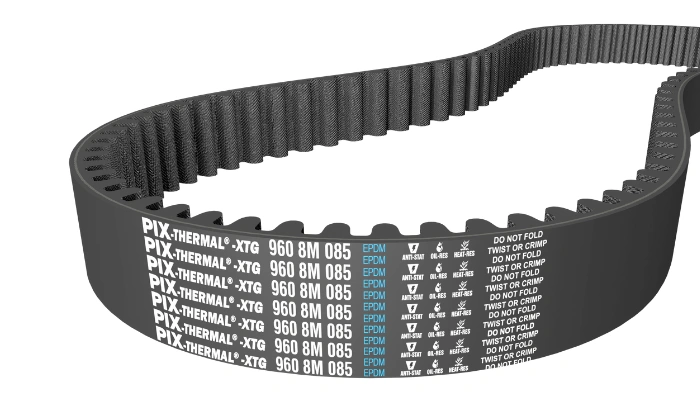How to Choose the Right Timing Belt for Industrial Applications

Choosing the right timing belt may seem simple at first glance. But the reality is that a small mismatch can lead to reduced performance, higher maintenance costs, or even machine breakdowns. Whether you’re running an assembly line, a packaging unit, or any other industrial setup, understanding what makes one belt different from another can make a big difference.
Let’s break down the process step by step, so you can make the right choice confidently.
Understanding What a Timing Belt Does
A timing belt is like the backbone of many machines. It connects rotating shafts and ensures they move in perfect sync. Unlike flat or V-belts, timing belts have teeth that prevent slipping, allowing precise movement even at high speeds.
When a belt fails, it’s often not because it’s “bad,” but because it wasn’t the right match for the job. That’s why knowing the right specifications matters.
Note:
Choosing the right Timing Belts (Зубчатые ремни) can save you from costly downtime and improve machine efficiency. If you’re looking for reliable industrial solutions, Pix Trans Russia offers a wide range of options designed for various operating conditions. Contact them today to find the best fit for your industrial setup and keep your systems running smoothly.
Key Factors to Consider Before Choosing a Timing Belt
1. Load Capacity
Different machines put different levels of stress on a belt.
If your system handles heavy loads, you need a reinforced belt with strong tensile cords.
For lighter operations, a standard rubber or polyurethane belt works well.
2. Operating Environment
Temperature, humidity, and exposure to chemicals all affect belt performance.
High temperatures: Use heat-resistant materials like neoprene.
Dusty or oily environments: Choose belts with anti-static or oil-resistant coatings.
Cold storage or freezing conditions: Go for belts that stay flexible at low temperatures.
3. Speed and Torque Requirements
Speed and torque go hand in hand. The faster the rotation or the higher the torque, the stronger and more precise the belt needs to be. Always check the manufacturer’s ratings before buying.
4. Belt Pitch and Tooth Design
The pitch refers to the distance between two belt teeth. A smaller pitch gives smoother movement, while a larger pitch handles more power. Choose based on the machine’s performance needs.
Comparison of Common Belt Materials
Material Type Best For Temperature Resistance Durability Level
Rubber (Neoprene) General industrial use Medium Good
Polyurethane (PU) High-precision, clean environments High Very Good
Fiberglass Reinforced High load and torque Medium Excellent
Kevlar or Steel Reinforced Heavy-duty machines Very High Exceptional
Matching the Belt to Your Industry
Every industry has unique needs. For example:
Packaging lines need belts that can run quietly and consistently.
Food processing requires non-toxic, easy-to-clean materials.
Automotive systems demand high strength and heat resistance.
Knowing your specific use case helps narrow down the options and ensures long-term reliability.
Common Signs You’re Using the Wrong Belt
Symptom Possible Cause Suggested Fix
Belt Slipping Incorrect tension or pitch Recheck tension and pulley alignment
Cracked Teeth Overload or wrong material Use stronger or heat-resistant material
Noise or Vibration Misalignment or worn pulleys Inspect pulleys and alignment
Frequent Replacement Poor material choice Select a belt suited to your environment
Why Regular Inspection Is Essential
Even the best belt won’t last forever. Over time, wear and stretch are unavoidable. Conducting routine inspections helps you spot early warning signs like:
Frayed edges
Missing teeth
Uneven wear marks
Early detection prevents sudden breakdowns that could stop your entire operation.
A Quick Tip Before You Buy
Always consider the manufacturer’s reputation and technical support. A trusted brand ensures quality control, accurate data sheets, and availability of spare parts. While cost matters, reliability always pays off in the long run.
Frequently Asked Questions (FAQs)
1. How often should I replace a timing belt in an industrial setup?
It depends on the operating hours and load. On average, timing belts should be inspected every 3–6 months and replaced every 2–3 years.
2. Can I use the same belt for different machines?
Not always. Each machine has different torque, tension, and pulley design requirements, so always match the belt to the exact specification.
3. What’s the difference between a timing belt and a V-belt?
Timing belts have teeth that prevent slipping, while V-belts rely on friction. Timing belts are ideal for precision and synchronization.
4. What happens if the timing belt is too tight?
An overly tight belt can strain bearings and pulleys, leading to early wear or system failure. Proper tensioning is crucial.
5. Are polyurethane belts better than rubber belts?
Both have benefits. Polyurethane belts resist chemicals and temperature better, while rubber belts are flexible and affordable for general use.
Visit:Pix Trans Russia
For more infomatic content Visit flexartsocial
- Art
- Causes
- Crafts
- Dance
- Drinks
- Film
- Fitness
- Food
- Jocuri
- Gardening
- Health
- Home
- Literature
- Music
- Networking
- Alte
- Party
- Religion
- Shopping
- Sports
- Theater
- Wellness



